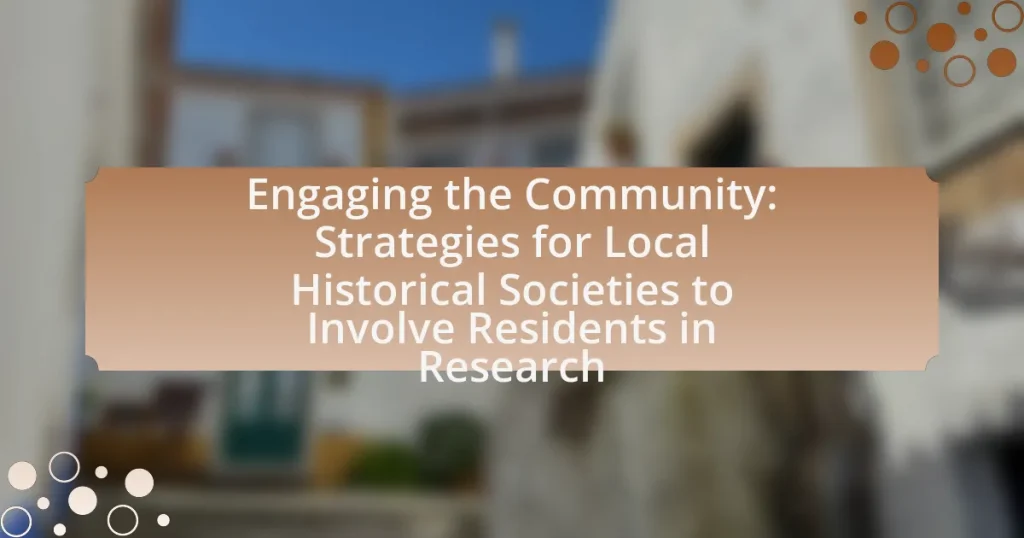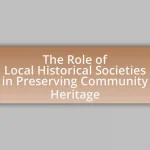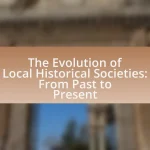The article focuses on strategies for local historical societies to engage their communities in historical research. It outlines key methods such as organizing interactive workshops, utilizing social media, and forming partnerships with schools and organizations to enhance participation. The article also discusses how to identify community interests through surveys and forums, the importance of collaboration, and the role of technology in facilitating involvement. Additionally, it addresses challenges faced by historical societies, including funding limitations and the need for inclusivity, while providing practical tips for sustaining community engagement over time.
What are the key strategies for engaging the community in local historical research?
Key strategies for engaging the community in local historical research include organizing interactive workshops, utilizing social media platforms, and fostering partnerships with local schools and organizations. Interactive workshops allow community members to actively participate in research activities, enhancing their connection to local history. Social media platforms serve as effective tools for sharing historical content and encouraging discussions, thereby increasing community involvement. Collaborating with local schools and organizations can provide additional resources and outreach opportunities, making historical research more accessible and relevant to residents. These strategies have been shown to increase participation and interest in local history, as evidenced by successful programs implemented by various historical societies across the country.
How can local historical societies identify community interests?
Local historical societies can identify community interests by conducting surveys and hosting community forums. Surveys allow societies to gather quantitative data on topics of interest, while forums facilitate qualitative discussions, enabling residents to express their historical interests and concerns directly. Research indicates that engaging community members through these methods leads to a better understanding of local priorities, as evidenced by a study from the American Association for State and Local History, which found that 75% of participants felt more connected to their local history when involved in such initiatives.
What methods can be used to gather community input on historical topics?
Methods to gather community input on historical topics include surveys, focus groups, public meetings, and online platforms. Surveys allow for quantitative data collection from a broad audience, while focus groups facilitate in-depth discussions among selected participants, providing qualitative insights. Public meetings encourage community engagement and direct feedback, fostering a sense of ownership in historical narratives. Online platforms, such as social media and dedicated websites, enable wider participation and can reach diverse demographics, enhancing the richness of community input. These methods are effective in capturing a range of perspectives and experiences related to historical topics.
How do community interests shape research priorities for historical societies?
Community interests significantly shape research priorities for historical societies by guiding the focus of investigations toward topics that resonate with local populations. Historical societies often conduct surveys, hold public meetings, and engage in discussions to identify the interests and concerns of community members, ensuring that their research reflects the values and narratives important to those they serve. For instance, a historical society in a region with a rich immigrant history may prioritize research on the contributions of immigrant communities, as this aligns with the interests expressed by local residents. This alignment not only fosters community engagement but also enhances the relevance and impact of the research conducted by these societies.
What role does collaboration play in community engagement?
Collaboration is essential in community engagement as it fosters shared ownership and collective action among community members. When individuals and organizations work together, they leverage diverse skills, perspectives, and resources, which enhances the effectiveness of engagement efforts. Research indicates that collaborative approaches lead to increased participation rates and stronger community ties, as seen in initiatives where local historical societies partner with residents to co-create projects. This synergy not only empowers individuals but also builds trust and a sense of belonging, ultimately resulting in more sustainable community engagement outcomes.
How can partnerships with local organizations enhance research efforts?
Partnerships with local organizations can enhance research efforts by providing access to community knowledge, resources, and networks. Local organizations often possess valuable insights into regional history, culture, and demographics, which can inform and enrich research projects. For instance, collaboration with historical societies can lead to the discovery of unique archival materials and oral histories that may not be available through traditional academic channels. Additionally, these partnerships can facilitate community engagement, increasing participation in research initiatives and ensuring that the findings are relevant and beneficial to the local population. This collaborative approach has been shown to improve the quality and impact of research by aligning it more closely with community needs and perspectives.
What are the benefits of involving schools and educational institutions?
Involving schools and educational institutions enhances community engagement and fosters a sense of shared responsibility for local history. Educational institutions serve as platforms for students to learn about their community’s heritage, which can lead to increased interest in local historical societies. Research indicates that when students participate in community projects, such as historical research, they develop critical thinking skills and a deeper understanding of their cultural identity. For example, a study by the National Council for the Social Studies found that students engaged in local history projects showed a 30% increase in civic knowledge and participation. This collaboration not only benefits students academically but also strengthens community ties and promotes the preservation of local history.
How can technology facilitate community involvement in historical research?
Technology facilitates community involvement in historical research by providing accessible platforms for collaboration and information sharing. Digital tools such as online databases, social media, and crowdsourcing applications enable local historical societies to engage residents in documenting, preserving, and interpreting local history. For instance, platforms like Historypin allow users to upload historical photos and stories, fostering community contributions and enhancing collective memory. Additionally, virtual workshops and webinars can educate community members about historical research methods, empowering them to participate actively. The use of Geographic Information Systems (GIS) also allows communities to visualize historical data spatially, making it easier for residents to connect with their local heritage.
What digital tools can be utilized for community engagement?
Digital tools that can be utilized for community engagement include social media platforms, community forums, and survey tools. Social media platforms like Facebook and Twitter facilitate real-time communication and information sharing, allowing historical societies to reach a broader audience. Community forums, such as Nextdoor or Reddit, enable localized discussions and foster connections among residents. Survey tools like SurveyMonkey or Google Forms gather feedback and insights from community members, enhancing participation in research initiatives. These tools collectively enhance interaction, promote transparency, and encourage active involvement in local historical projects.
How can social media platforms be leveraged to promote historical projects?
Social media platforms can be leveraged to promote historical projects by creating engaging content that highlights the significance and relevance of the projects to the community. Utilizing visually appealing posts, such as images of historical artifacts or sites, can attract attention and encourage sharing among users. Additionally, interactive features like polls, quizzes, and live discussions can foster community involvement and generate interest in local history.
For instance, the National Park Service effectively uses social media to promote historical sites by sharing stories and historical facts, which increases public awareness and visitation. Furthermore, targeted advertising on platforms like Facebook can reach specific demographics interested in history, enhancing project visibility.
What are effective outreach strategies for local historical societies?
Effective outreach strategies for local historical societies include community events, partnerships with schools, and social media engagement. Community events, such as open houses or historical reenactments, attract local residents and foster interest in local history. Collaborating with schools allows historical societies to integrate local history into educational curricula, reaching younger audiences. Social media platforms enable societies to share stories, artifacts, and upcoming events, increasing visibility and engagement. These strategies have been shown to enhance community involvement and awareness of local history, as evidenced by increased attendance at events and participation in programs.
How can historical societies create engaging programs and events?
Historical societies can create engaging programs and events by incorporating interactive elements, such as hands-on workshops, guided tours, and community storytelling sessions. These activities foster participation and allow attendees to connect personally with historical narratives. For instance, a study by the American Association for State and Local History found that interactive programs significantly increase visitor engagement and satisfaction, leading to higher attendance rates. By utilizing local history and involving community members in the planning process, historical societies can ensure that their events resonate with the interests and experiences of the audience, thereby enhancing community involvement and appreciation for local heritage.
What types of events attract community participation?
Community participation is primarily attracted by events that foster social interaction, education, and cultural engagement. Examples include local festivals, workshops, historical reenactments, and community service projects. These events encourage residents to connect with one another and their local history, as evidenced by studies showing that community festivals can increase social cohesion and participation rates. For instance, a report by the National Endowment for the Arts highlights that arts and cultural events significantly enhance community involvement and pride.
How can historical societies ensure inclusivity in their programs?
Historical societies can ensure inclusivity in their programs by actively engaging diverse community members in the planning and execution of events. This approach involves conducting outreach to underrepresented groups, incorporating their perspectives and histories into programming, and providing accessible resources and materials. For instance, a study by the American Alliance of Museums highlights that inclusive practices, such as multilingual materials and adaptive technologies, significantly enhance participation from various demographics. By prioritizing these strategies, historical societies can create a welcoming environment that reflects the community’s diversity and fosters broader participation.
What communication strategies are essential for engaging residents?
Effective communication strategies essential for engaging residents include active listening, transparent information sharing, and utilizing multiple channels for outreach. Active listening fosters trust and ensures that residents feel heard, which is crucial for community engagement. Transparent information sharing builds credibility and keeps residents informed about ongoing projects and opportunities for involvement. Utilizing multiple channels, such as social media, newsletters, and community meetings, ensures that diverse demographics are reached, accommodating varying preferences for communication. These strategies are supported by research indicating that communities with strong communication practices experience higher levels of participation and satisfaction among residents.
How can newsletters and local media be used to inform the community?
Newsletters and local media can effectively inform the community by providing timely updates, sharing relevant historical information, and promoting community events. Newsletters serve as a direct communication tool, allowing local historical societies to disseminate curated content that highlights local history, upcoming research opportunities, and ways for residents to engage. Local media, including newspapers and radio stations, can amplify these messages, reaching a broader audience and fostering community interest in historical initiatives. For instance, studies show that communities with active local media coverage experience higher participation rates in events and programs, demonstrating the impact of these communication channels on community engagement.
What role does storytelling play in attracting community interest?
Storytelling plays a crucial role in attracting community interest by creating emotional connections and fostering a sense of belonging among residents. When local historical societies share narratives that resonate with the community’s identity, they engage individuals on a personal level, making history relevant and relatable. Research indicates that storytelling can enhance community participation; for instance, a study by the National Endowment for the Humanities found that storytelling initiatives significantly increased local engagement in cultural programs. By weaving together personal experiences and historical context, storytelling not only informs but also inspires community members to participate actively in local research and events.
What are the challenges faced by local historical societies in community engagement?
Local historical societies face several challenges in community engagement, primarily including limited funding, lack of visibility, and difficulty in attracting diverse audiences. Limited funding restricts their ability to host events, maintain facilities, and develop outreach programs, which are essential for engaging the community. Additionally, many societies struggle with visibility, as they often operate in obscurity and lack effective marketing strategies to promote their activities. This results in low community awareness and participation. Furthermore, attracting a diverse audience is challenging due to generational gaps in interest, cultural differences, and competing local activities, which can lead to a homogeneous membership that does not reflect the broader community. These challenges hinder the effectiveness of local historical societies in fostering meaningful connections with residents.
How can historical societies overcome barriers to participation?
Historical societies can overcome barriers to participation by implementing inclusive outreach strategies that engage diverse community members. These strategies include hosting events in accessible locations, offering programs in multiple languages, and utilizing social media to reach a broader audience. Research indicates that when historical societies actively seek input from underrepresented groups, such as minorities and youth, they can significantly increase participation rates. For example, a study by the American Alliance of Museums found that organizations that prioritize community engagement see a 30% increase in attendance and involvement.
What strategies can be implemented to address apathy or disinterest?
To address apathy or disinterest, local historical societies can implement strategies such as interactive community events, targeted outreach, and collaborative projects. Interactive community events, like workshops or history fairs, actively engage residents by allowing them to participate in hands-on activities related to local history. Targeted outreach, including personalized invitations and social media campaigns, can help reach specific demographics that may feel disconnected. Collaborative projects, such as partnering with schools or local organizations, foster a sense of ownership and relevance among residents, encouraging their involvement in historical research. These strategies have been shown to increase community engagement and participation in local history initiatives.
How can funding limitations be navigated to support engagement efforts?
Funding limitations can be navigated to support engagement efforts by leveraging partnerships and community resources. Local historical societies can collaborate with schools, universities, and other organizations to share resources and expertise, which can reduce costs and enhance engagement initiatives. For instance, a partnership with a university may provide access to student volunteers who can assist with research and outreach activities, thereby minimizing the need for financial investment. Additionally, applying for grants specifically aimed at community engagement can provide necessary funding; according to the National Endowment for the Humanities, grants can support projects that foster public participation in historical research. By utilizing these strategies, historical societies can effectively engage their communities despite financial constraints.
What are the best practices for sustaining community involvement over time?
The best practices for sustaining community involvement over time include fostering strong relationships, providing ongoing education, and creating opportunities for meaningful participation. Strong relationships between local historical societies and community members encourage trust and commitment, which are essential for long-term engagement. Ongoing education, such as workshops and informational sessions, keeps the community informed and invested in historical research. Additionally, creating opportunities for meaningful participation, such as volunteer roles or collaborative projects, allows residents to contribute actively, reinforcing their connection to the society and its mission. These practices are supported by research indicating that sustained engagement is linked to perceived value and relevance of the activities offered by the organization.
How can feedback mechanisms be established to improve engagement?
Feedback mechanisms can be established to improve engagement by implementing regular surveys and community forums that solicit input from residents. These tools allow local historical societies to gather valuable insights on community interests and preferences, fostering a sense of ownership and involvement. Research indicates that organizations that actively seek feedback see a 30% increase in participant engagement, as noted in a study by the National Endowment for the Arts. By analyzing the feedback collected, societies can tailor their programs and initiatives to better align with community needs, thereby enhancing overall participation and satisfaction.
What role does recognition and appreciation play in maintaining community interest?
Recognition and appreciation are crucial in maintaining community interest as they foster a sense of belonging and validation among members. When individuals feel acknowledged for their contributions, they are more likely to engage actively in community activities. Research indicates that communities with strong recognition practices experience higher levels of participation; for instance, a study by the National Endowment for the Arts found that communities that celebrate local achievements see a 30% increase in volunteerism. This correlation underscores the importance of recognition and appreciation in sustaining enthusiasm and involvement within the community.
What practical tips can local historical societies implement for effective community engagement?
Local historical societies can implement practical tips for effective community engagement by organizing interactive events, such as workshops and guided tours, that invite community participation. These events foster a sense of ownership and connection to local history, encouraging residents to share their stories and experiences. Additionally, societies can utilize social media platforms to promote their activities and engage with a broader audience, facilitating discussions and feedback. Collaborating with local schools and organizations can also enhance outreach efforts, as educational programs can be tailored to involve students and families in historical research projects. Research indicates that community involvement in local history initiatives increases public interest and participation, as seen in successful programs across various regions.















